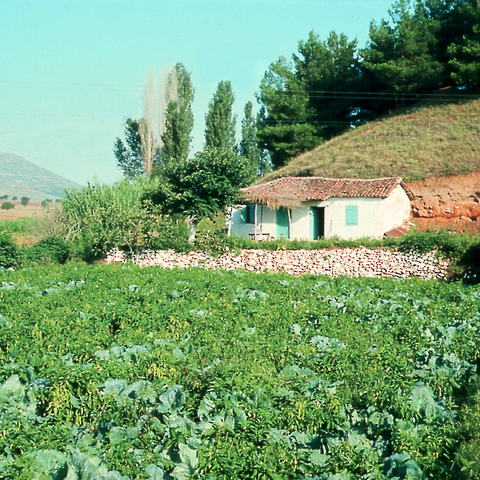2.3. Assiros toumba in the 8th and 7th centuries BC: the apsidal structures of phase 1 and their function
K.A. Wardle - D. Wardle
Introduction
The settlement at Assiros Toumba, in the western end of the Langadas basin some 23 km north of Thessaloniki beside the road to Serres, was first established around 2000 BC and continued to be an important centre in the district until c 900 BC when it was abandoned for well over a hundred years. During this time the timber-framed mud brick houses were reconstructed again and again and the defensive banks which surrounded the settlement were regularly raised and reinforced so that eventually the Toumba reached a height of some 14 m above the surrounding countryside (Fig. 1). Throughout this long period of occupation there are signs of contact with southern Greece - Mycenaean and then Protogeometric - while in the 13th century BC it was clearly a central place providing granaries for a much larger community than that which occupied the relatively restricted summit. By the beginning of the Iron Age the area available on the summit of the mound had been reduced to some 70 x 40 m and it is likely that it was abandoned for a more spacious site after one of the many fires which devastated the settlement at intervals.
Around 750 BC, new buildings were constructed on the summit, but these were of a very different kind to their predecessors. Instead of the regularly arranged rectangular houses of the village settlements of previous centuries, two large apsidal structures were erected across the southern end of the mound while a number of smaller ancillary structures were built in the east and north, leaving an open space -perhaps a courtyard- in the centre. Among the finds were large storage jars -pithoi- and numbers of jugs and drinking vessels as well as fragments of large kraters -mixing bowls- capable of holding nearly 25 litres. The buildings and their context suggest a specialised function within a wider community who lived in the district, either on the large defensive ʻtableʼ sites such as that at Agia Anna a few km away, or in the small scattered farmsteads or hamlets which can be identified for the first time in the Iron Age. The exact function may never be certain but among the possibilities discussed below are those of a chief's residence, a focus for social communal activity or a nodal position in the newly developed Iron Age trade networks while the absence of any objects with specific cult associations seems to rule out any primarily religious use.
Whichever is the correct interpretation, these structures reflect the many social changes which were taking place in Central Macedonia from the middle of the 8th century BC onwards, a period which sees the development of the first urban scale settlements as well as the formal colonisation of numerous coastal sites reported in the historical sources.
Excavation at this site was conducted by the authors for the British School at Athens and the University of Birmingham between 1975 and 1989 with the wholehearted support of the XVI Ephoria of Prehistoric and Classical Antiquities, and its successive directors, Dr Katerina Rhomiopoulou and the late Dr Ioulia Vokotopoulou and the sponsorship of the British Academy, Alexander von Humboldt Stiftung, Institute for Aegean Prehistory and National Geographic Society of America among many others. Numerous articles have reported different aspects of the finds and the final report on the Iron Age levels will be published shortly by the British School at Athens.[49]
49 An earlier version of this account with illustrations of much of the pottery was published in K.A. Wardle and Diana Wardle, «Assiros Toumba: Remains of the later Iron Age» in Μύρτος, Μελέτεςστη Μνήμη της Ιουλίας Βοκοτοπούλου: 653-673, where full references can be found to articles on other aspects of the discoveries. The principal preliminary reports to date which relate to the Iron Age at Assiros are published in the Annual of the British School at Athens (BSA) 75 (1980), 229-265; 82 (1987), 313-329; 83 (1988), 375-387; 84 (1989), 447-463 and in ΑΕΜΘ 10, 443-460.



